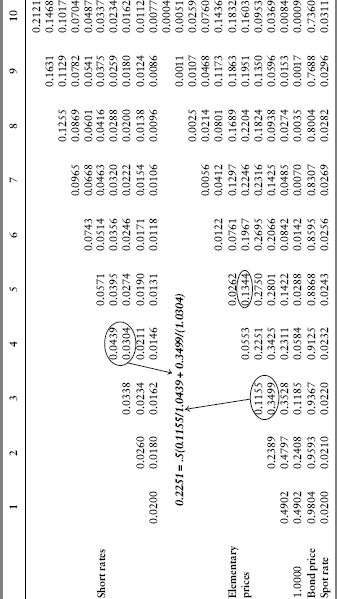Basics of Pricing Interest Rate Derivatives
An investment in any collateralized obligation is the purchase of an asset whose value, like any bond, is determined by discounting its expected cash flows. Because cash flows in the form of principal and interest are received over time, the discount rates used will generally be tied to the term structure. Intuitively, the investor prices the bond today as the weighted average of the present values of the bond's cash flows using various paths that discount rates may take over time, depending on their inherent volatility.
Drawing from our term structure work in Chapter 3 and options work in Chapter 16, we can construct a lattice that models short-rate volatility over time. Examples can be found in the spreadsheet accompanying this chapter. For starters, let's assume that annual volatility in short rates can be modeled using parameter choices u = 1.3 and d = 0.9. We develop this model in more detail further on but, for now, we are interested in the underlying intuition. Assuming the one-year short rate is equal to 2 percent, we present a lattice covering a 10-year period in the top half of Figure 20.6 consistent with these parameter choices. Now, consider a one-dollar par bond. The elementary price of this bond is $1 at time zero. The forward values of this bond are given in the lower lattice and are consistent with the term structure embedded in the short rates. You can examine in detail how this lattice was constructed by referring to the chapter spreadsheet.
Figure 20.6 A 10-Year Short-Rate Lattice

We compute the elementary price in state s at time t, ![]() , as the equal-weighted discounted average of the two previous elementary prices using the following rule at each node and where
, as the equal-weighted discounted average of the two previous elementary prices using the following rule at each node and where ![]() is the reciprocal of the short rate in the top lattice.
is the reciprocal of the short rate in the top lattice.
The bond prices given in the second-to-last row are the sums of the elementary prices. It is easy to prove algebraically that these prices are the discounted sum of the previous period's elementary prices. For example, the bond price two years from now is equal to the discounted sum of the possible bond prices one year from now:
![]()
These bond prices are therefore consistent with the term structure represented by the short-rate structure in our lattice. They are therefore zero coupon fixed income securities.
The spot rates given in the last row are estimated directly from the bond prices and are therefore consistent with the short-rate lattice. The problem, however, is that they may not be consistent with the observed term structure, and this is the problem we turn to now.
